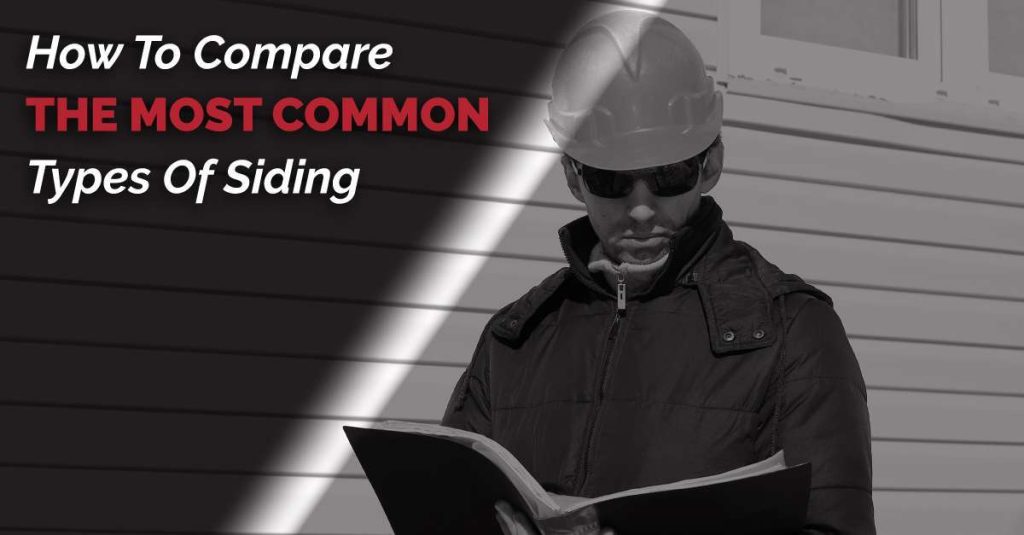Exterior siding acts as the first line of defense against the elements and is first by visitors and buyers. There are many different siding options for your next build, from wood to vinyl to fiber cement. Choosing the right siding option among all of the different types available involves several considerations. In this guide, we break down the five most common types of siding to help you make an informed choice.
1. Wood Siding
Wood siding is one of the most attractive siding options on the market. Common types of wood siding include wood shingles, planks, panels, and boards. Wood clapboard lap siding is among the oldest types of home siding, and you can find them on many historic homes. The most notable drawback of wood siding is its high cost and relatively demanding maintenance needs.
You will need to inspect your siding annually for damage or cracks and schedule prompt repairs. Wood also requires refinishing after every 4-6 months (depending on the type of finish you choose). Generally, wood siding offers a life expectancy of 15-40 years.
The Pros:
- Easy to cut, shape, and install
- Natural aesthetics
- A wide array of wood species and grades to choose from
- It can last for decades with proper maintenance
The Cons:
- Costly
- Demands diligent maintenance
- Vulnerable to termites, woodpeckers, and rot
2. Engineered Wood
If you adore the look, feel, and functionality of solid wood but not the high price tag of cedar siding or the demanding maintenance needs of pine, then engineered wood siding could be the answer. There are multiple choices of engineered siding, including clapboards made from wood flakes and resin. Most wood siding options can be installed directly over wood framing, eliminating the need for exterior sheathing. With the correct maintenance, engineered wood siding lasts up to 60 years.
Pros:
- Strong enough to withstand extreme weather conditions
- It is available in various textures and styles, including rough-sawn clapboard, wood shingles, and beaded lap.
- It comes with factory finishes or primed and ready to paint.
Cons:
- Earlier versions had moisture issues
3. Vinyl Siding
Vinyl siding is solid, long-lasting, easy to install, and affordable. Today, vinyl siding is available in various styles and colors, including models which mimic stone, wood-grain lap siding, or wood shingles. And since the color is part and parcel of the material, dings and scratches won’t show. Routine cleaning with a brush and garden hose is all you need to maintain your vinyl siding. With the proper maintenance, vinyl siding often lasts 20-40 years.
If you need extra insulation, you can choose insulated vinyl siding with a backing of rigid foam insulation, filling the voids behind the siding’s stepped profile. It adds an insulation value of R-2 to R-6 and makes the siding more resistant to impact damage. Overall, vinyl siding is easy to handle and install.
Pros:
- Relatively inexpensive
- Quite versatile
- Can be installed over existing materials
- Quick and easy installation
- Available in a variety of beautiful colors and textures
Cons:
- Grime and mold can build up on the surface
- Vinyl is vulnerable to weather damage
- The ends require overlapping
4. Fiber Cement
Fiber cement is made from cellulose fibers and cement compressed and formed into various siding products. You can choose from clapboards, panels, boards, battens, and exterior trim. The product is solid and dimensionally stable. It takes paint exceptionally well, meaning a longer life for any paint job.
Tests conducted by various entities have found quality fiber cement siding products could last for over 100 years when installed and maintained by a certified siding contractor. Other conservative estimates place the life expectancy of this siding material at 50 to 60 years.
Pros:
- Moisture and rot-resistant
- Non-combustible
- Pest resistant
- Weather-resistant
- Low maintenance and stability
- It is available in many styles and textures, mimicking stucco, wood, shingles, wood clapboard, and masonry.
Cons:
- Heavy and requires special installation tools and techniques
- Usually needs refinishing after 15 years
5. Aluminum Siding
Since the 1930s, aluminum siding has been used to protect homes and make them more aesthetically appealing. Aluminum is considered a durable, affordable, and long-lasting alternative to natural wood siding. Although many homeowners today prefer vinyl siding, aluminum siding is still an effective siding option for protecting homes from harsh environmental factors. Aluminum siding typically lasts 20-40 years with proper maintenance.
Pros:
- Cost-effective and easy to install
- Eco-friendly
- Durable and long-lasting
- Low Maintenance
Cons:
- Can be noisy
- Prone to minor damage
- Can become worn and faded
- Out of style
Choosing among the many different types of house siding should not be an overwhelming process. Consulting with a trusted local siding can help you feel confident with your final choice. At AIC Roofing & Construction, we can help you choose an appropriate siding solution for your home in Central Kentucky. Contact us today to schedule your free consultation!
Default insurance Lexington Louisville Richmond roof replacement
